United States House of Representatives elections, 1936
|
|
|||||||||||||||||||||||||||||||||||||||||||||||||||||
|---|---|---|---|---|---|---|---|---|---|---|---|---|---|---|---|---|---|---|---|---|---|---|---|---|---|---|---|---|---|---|---|---|---|---|---|---|---|---|---|---|---|---|---|---|---|---|---|---|---|---|---|---|---|
|
|||||||||||||||||||||||||||||||||||||||||||||||||||||
|
All 435 seats to the United States House of Representatives 218 seats needed for a majority |
|||||||||||||||||||||||||||||||||||||||||||||||||||||
|
|||||||||||||||||||||||||||||||||||||||||||||||||||||
|
|||||||||||||||||||||||||||||||||||||||||||||||||||||
The 1936 United States House of Representatives elections was an election for the United States House of Representatives in 1936 which coincided with President Franklin Delano Roosevelt's landslide re-election. Roosevelt's Democratic Party gained twelve more net seats from the Republican Party, bringing them above a three-fourths majority. This was the largest majority since Reconstruction. The last time a party won so decisively was in 1866.
Significant representation from the Progressives of Wisconsin and Farmer-Labor Party of Minnesota is also seen, as these two liberal populist groups gained a foothold.
The 1936 elections showed the continuing trust for the American people in that Roosevelt would guide the nation from depression. Despite setbacks, the people had faith in the New Deal and elected leaders who supported its measures. This was the last of four straight election losses for Republicans due to the lingering effects of the Depression.
...
Wikipedia




